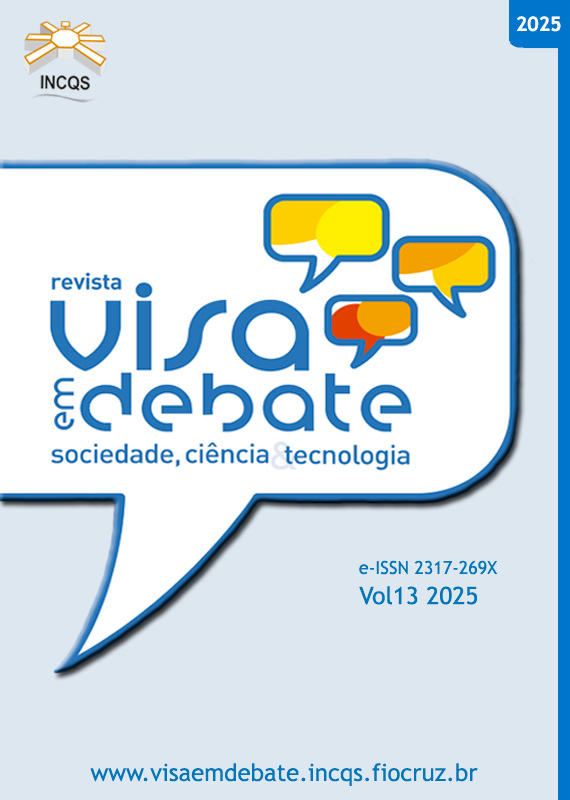Tuberculosis in Fernandópolis, São Paulo, Brazil: an integrated one health approach
Vigil Sanit Debate, Rio de Janeiro, 2025, v.13: e02379 | Published on: 15/10/2025
DOI:
https://doi.org/10.22239/2317-269X.02379Keywords:
Neglected Disease, Epidemiology, Vulnerable Population, Mycobacterium tuberculosisAbstract
Introduction: Tuberculosis (TB) is a neglected disease of great importance for public health, as it affects countless people annually. Objective: To describe the socio-epidemiological profileof those affected by TB in the municipality of Fernandópolis, from 2014 to 2023. Method: This cross-sectional, descriptive, retrospective, and quantitative study used secondary data from the Notifiable Diseases Information System (Sinan). The variables analyzed were: year, month, age, race/color, education, type of entry, associated risk factors, clinical form, diagnosis, treatment, and evolution. Results: 159 cases of TB were reported. The profile of those affected stood out as male individuals, aged 20 to 39, with incomplete secondary education and residents of urban areas. 20 cases of TB were reported in HIV co-infected patients. The most prominent clinical form was pulmonary, and among those affected, 42.0% did not complete or abandoned treatment. The lethality coefficient was 4.4%, and the mortality rate was 2 deaths per 100,000 inhabitants. Conclusions: An increase in the prevalence of TB cases was observed. Given this scenario, it is essential that the approach to the disease goes beyond the medical issue, incorporating strategies based on single health to promote health and improve the quality of life of affected population groups. This integrated view is crucial for addressing the multifaceted challenges of TB, addressing treatment and the social, economic, and environmental determinants that contribute to its spread.
Downloads
References
1. Ministério da Saúde (BR). Tuberculose. Biblioteca Virtual em Saúde. 2020[acesso 15 jan 2023]. Disponível em: https://bvsms.saude.gov.br/tuberculose-21/
2. Ministério da Saúde (BR). Manual com orientações clínicas e de vigilância para a tuberculose zoonótica. Brasília: Ministério da Saúde; 2023[acesso 13 jun 2024]. Disponivel em: https://bvsms.saude.gov.br/bvs/publicacoes/manual_orientacoes_vigilancia_tuberculose_zoonotica.pdf
3. Guimaraes ABG, Mello DC, Sousa LAC, Silva STF, Souza VF. A história da tuberculose associada ao perfil socioeconômico no Brasil: uma revisão da literatura. Cad Grad Cienc Biol Saúde Unit. 2018;3(3):43-52.
4. Ministério da Saúde (BR). Brasil Livre da tuberculose: plano nacional pelo fim da tuberculose como problema de saúde pública. Brasília: Ministério da Saúde; 2017[acesso 15 jul 2023].Disponível em: https://bvsms.saude.gov.br/bvs/publicacoes/brasil_livre_tuberculose_plano_nacional.pdf
5. Lima DE. Bovine tuberculosis in safari park in Brazil. Pesq Vet Bras. 2021;41:1-5. https://doi.org/10.1590/1678-5150-PVB-6719
6. United Nations Environment Programme – UNEP. Prevenindo a próxima pandemia: doenças zoonóticas e como quebrar a cadeia de transmissão. Nairobi: United Nations Environment Programme; 2020[acesso 24 set 2023]. Disponível em: https://www.unep.org/pt-br/resources/report/preventingfuture-zoonotic-disease-outbreaks-protecting-environmentanimals-and
7. Trajman A, Saraceni V, Durovni B. Os objetivos do desenvolvimento sustentável e a tuberculose no Brasil:desafios e potencialidades.Cad Saúde Pública. 2018;34(6):1-4. https://doi.org/10.1590/0102-311X00030318
8. Instituto Brasileiro de Geografia e Estatística – IBGE. Cidades e estados do Brasil. Rio de Janeiro: Instituto Brasileiro de Geografia e Estatística; 2024[acesso 10 maio 2024]. Disponível em: https://cidades.ibge.gov.br/brasil/sp/panorama
9. Secretaria Municipal de Saúde de Fernandópolis. Redes de atenção a saúde. Fernandópolis: Secretaria Municipal de Saúde; 2024.
10. Pereira MG. Epidemiologia: teoria e prática. Rio de Janeiro: Guanabara Koogan; 2017.
11. R Core Team. R: A language and environment for statistical computing. Vienna: R Foundation for Statistical Computing; 2019[acesso 1 fev 2023]. Disponível em: https://www.R-project.org/
12. Ministério da Saúde (BR). Datasus: Tabnet. Brasília: Ministério da Saúde; 2024[acesso 2 jan 2024]. Disponível em: https://datasus.saude.gov.br/informacoes-de-saude-tabnet/
13. Pereira ALG, Silva AF, Coimbra CO, Freitas LGP, Soares LS, Duarte PD et al. Análise do perfil epidemiológico da tuberculose no estado de Minas Gerais. Rev Bras Rev Saúde. 2022;2:4332-42. https://doi.org/10.34119/bjhrv5n2-028
14. Dantas RT. Dinâmica climática e a incidência de tuberculose em Manaus, AM [dissertação de mestrado]. Manaus:Universidade Federal do Amazonas; 2022[acesso 13 jun 2024].Disponível em: https://tede.ufam.edu.br/bitstream/tede/9888/11/DISS_RebecaDantas_PPGEOG.pdf
15. INMET. Instituto Nacional de Meteorologia. Banco de dados Metereológicos. 2024[acesso 13 jun 2024]. Disponível em: https://tempo.inmet.gov.br/TabelaEstacoes/A001
16. Fares A. Seasonality of tuberculosis. J Glob Infect Dis. 2011;3(1):46-55. https://doi.org/10.4103/0974-777X.77296
17. Ministério da Saúde (BR). Manual de recomendações para o controle da tuberculose no Brasil. Brasília: Ministério da Saúde; 2023[acesso 2 jun 2024]. Disponível em: https://www.gov.br/saude/pt-br/centrais-de-conteudo/publicacoes/svsa/tuberculose/manual-de-recomendacoese-controle-da-tuberculose-no-brasil-2a-ed.pdf/
18. Malacarne J. Desempenho de testes para o diagnóstico de tuberculose pulmonar em populações indígenas no Brasil: a contribuição do teste rápido molecular. J Bras Pneumol. 2019;45(2):1-7. https://doi.org/10.1590/1806-3713/e20180185
19. Santos BO, Brito TVR, Mesquita CR, Guimarães RJPS, Leão LA, Rocha MP. Space-temporal analysis of the incidence of tuberculosis in primary care. Res Med J.2017;21(2):1-6.
20. Costa MMR. Tuberculose pulmonar: perfil epidemiológico do sertão Pernambucano, Brasil. J Health Rev.2019;2(3):2228-38.
21. Souza AF. Análise do perfil epidemiológico da tuberculose na região nordeste do Brasil [Monografia de graduação]. Vitória de Santo Antão: Universidade Federal de Pernambuco; 2019[acesso 11 jun 2024]. Disponível em: https://repositorio.ufpe.br/handle/123456789/36238
22. Rodrigues OMM, Tauil PL. Aspectos clínicos e epidemiológicos da tuberculose no Distrito Federal (2006 a 2015). Rev Bras Epidemiol. 2019;22:1-14. https://doi.org/10.1590/1980-549720190055
23. Lopes IMG, Oliveira MFF, Jacy C, Santos AGL, Andrade MI. Análise da ocorrência de tuberculose em áreas rurais e urbanas de diferentes regiões brasileiras. In: Anais do I Congresso Norte-Nordeste de Atenção Integral à Saúde. Serra Talhada: Academics Eventos Acadêmicos; 2023[acesso 10 jun 2024]. Disponível em: https://www.even3.com.br/anais/iconneais2023/718125-analise-daocorrencia-de-tuberculose-em-areas-rurais-e-urbanas-dediferentes-regioes-brasileiras
24. Santos TA, Martins MMF. Perfil dos casos de reingresso após abandono do tratamento da tuberculose em Salvador, Bahia, Brasil. Cad Saúde Colet. 2018;26(3):233-40. https://doi.org/10.1590/1414-462X201800030235
25. Silva DR, Muñoz-Torrico M, Duarte R, Galvão T, Bonini EH, Arbex FF et al. Risk factors for tuberculosis: diabetes, smoking, alcohol use, and the use of other drugs. J Bras Pneumol. 2018;44(2):145-52. https://doi.org/10.1590/S1806-37562017000000443
26. Muñoz-Torrico M, Caminero-Luna J, Migliori GB, D’Ambrosio L, Carrillo-Alduenda JL, Villareal-Velarde H et al. Diabetes is associated with severe adverse events in multidrug-resistant tuberculosis. Arch Bronc. 2017;53(5):245-50.
27. Queiroz AAR, Berra TZ, Garcia MCC, Popolin MP, Belchior AS, Yamamura M et al. Padrão espacial e tendência temporal da mortalidade por tuberculose. Rev Latino-Am Enfermagem. 2018;26:1-10. https://doi.org/10.1590/1518-8345.2049.2992
28. Souza ASSI, Silva MLSJ, Miranda LN. Dificuldades na adesão do plano de tratamento pelo paciente com tuberculose. Cad Grad Cienc Biol Saúde Unit. 2017;4(2):297-311.
29. Melo MC, Barros H, Donalisio MR. Temporal trend of tuberculosis in Brazil. Cad Saude Publica. 2020;36(6). https://doi.org/10.1590/0102-311X00081319
30. World Health Organization – WHO. Roadmap for zoonotic tuberculosis. Geneva: World Health Organization; 2017[acesso 13 maio 2025]. Disponível em: https://www.who.int/publications/i/item/9789241513043
Downloads
Published
Issue
Section
License
Copyright (c) 2025 Health Surveillance under Debate: Society, Science & Technology

This work is licensed under a Creative Commons Attribution 4.0 International License.
COPYRIGHT ALLOWANCE The author (s) hereinafter designated as the ASSIGNOR hereby assign and transfer, free of charge, the ownership of the copyrights related to this ARTICLE to the Vigilância Sanitária em Debate: Sociedade, Ciência & Tecnologia (Health Surveillance under Debate: Society, Science & Technology) – Visa em Debate, represented by FUNDAÇÃO OSWALDO CRUZ, established at Av. Brasil, nº 4365, Manguinhos, Rio de Janeiro, RJ, Brazil, CEP 21045-900, under the conditions set out below: (a) The terms and conditions set forth in this Agreement shall apply to the following: 1. The ASSIGNOR declares that they s(he) is (are) the author (s) and owner (s) of the copyrighted property of the ARTICLE submitted. 2. The ASSIGNOR declares that the ARTICLE does not infringe the copyrights and / or other property rights of third parties, that the disclosure of images (if any) has been authorized and that they s(he) assume(s) full moral and / or property liability for its content, before third parties. 3. THE ASSIGNOR assigns and transfers all copyrights relating to the ARTICLE to the ASSIGNEE, especially the rights of editing, publication, translation into another language and reproduction by any process or technique. The ASSIGNEE becomes the exclusive owner of the rights related to the ARTICLE, and any reproduction, totally or partially, is prohibited in any other means of publicity, printed or electronic, without prior written authorization from the ASSIGNEE. 4. The assignment is free and, therefore, there will be no remuneration for the use of the ARTICLE by the ASSIGNEE.







